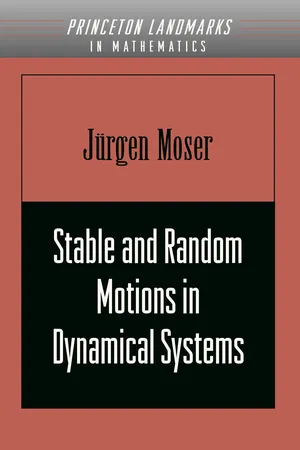
Stable and Random Motions in Dynamical Systems
With Special Emphasis on Celestial Mechanics (AM-77)
- 216 pages
- English
- PDF
- Available on iOS & Android
Stable and Random Motions in Dynamical Systems
With Special Emphasis on Celestial Mechanics (AM-77)
About this book
For centuries, astronomers have been interested in the motions of the planets and in methods to calculate their orbits. Since Newton, mathematicians have been fascinated by the related N-body problem. They seek to find solutions to the equations of motion for N masspoints interacting with an inverse-square-law force and to determine whether there are quasi-periodic orbits or not. Attempts to answer such questions have led to the techniques of nonlinear dynamics and chaos theory. In this book, a classic work of modern applied mathematics, Jürgen Moser presents a succinct account of two pillars of the theory: stable and chaotic behavior. He discusses cases in which N-body motions are stable, covering topics such as Hamiltonian systems, the (Moser) twist theorem, and aspects of Kolmogorov-Arnold-Moser theory. He then explores chaotic orbits, exemplified in a restricted three-body problem, and describes the existence and importance of homoclinic points. This book is indispensable for mathematicians, physicists, and astronomers interested in the dynamics of few- and many-body systems and in fundamental ideas and methods for their analysis. After thirty years, Moser's lectures are still one of the best entrées to the fascinating worlds of order and chaos in dynamics.
Frequently asked questions
- Essential is ideal for learners and professionals who enjoy exploring a wide range of subjects. Access the Essential Library with 800,000+ trusted titles and best-sellers across business, personal growth, and the humanities. Includes unlimited reading time and Standard Read Aloud voice.
- Complete: Perfect for advanced learners and researchers needing full, unrestricted access. Unlock 1.4M+ books across hundreds of subjects, including academic and specialized titles. The Complete Plan also includes advanced features like Premium Read Aloud and Research Assistant.
Please note we cannot support devices running on iOS 13 and Android 7 or earlier. Learn more about using the app.
Information
Table of contents
- Cover
- Title
- Copyright
- TABLE OF CONTENTS
- FOREWORD
- I. INTRODUCTION
- II. STABILITY PROBLEM
- III. STATISTICAL BEHAVIOR
- IV. FINAL REMARKS
- V. EXISTENCE PROOF IN THE PRESENCE OF SMALL DIVISORS
- VI. PROOFS AND DETAILS FOR CHAPTER III
- BOOKS AND SURVEY ARTICLES